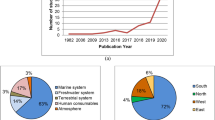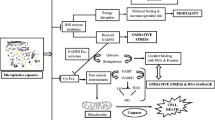Abstract
The decline of the European otter (Lutra lutra) seems to be related to environmental contamination especially with polychlorinated biphenyls (PCBs). Only a limited number of tissue samples from otters killed accidently as traffic victims or drowned in fishnets are available for residue analysis. Calculating the levels of PCBs in otter tissues from concentrations in fish and scats would be a very valuable tool to estimate potential risks for this endangered species. PCB levels measured in otter livers, scats and fish from a Middle European otter population were used to examine the suitability of mathematical models for calculating PCB concentrations in otter liver from fish concentrations and from scat levels. Our results suggest that the models and input parameters currently used to calculate PCB concentrations in otters to estimate risks do not predict mean concentrations in otter livers in our Middle European study area, giving lower concentrations than actually analysed in the tissues. Possible causes for the observed discrepancy between measured and calculated values are discussed.
Similar content being viewed by others
References
Foster-Turley, P., Mason, C. F. and Macdonald, S. M.: 1990, Otters. An Action Plan for Their Conservation, IUCN, Gland, Switzerland.
Green, J., Green, R. and Jefferies, D. J.: 1984, Lutra 27, 85.
Gutleb, A. C.: 1992, IUCN Otter Spec. Group Bull. 7, 4.
Hlavac, V.: 1995, Vydra 6, 9.
Hornshaw, T. C., Aulerich, R. J. and Johnson, H. E.: 1983, J. Toxicol. Environ. Health 11, 10.
Jefferies, D. J. and Hanson, H. M.: 1987, The Vincent Wildlife Trust Report 1986, London, UK, 42.
Kranz, A.: 1995, On the Ecology of Otters (Lutra lutra) in Central Europe. Thesis, University of Agriculture, Vienna, Austria.
Kruuk, H. and Conroy, J. W. H.: 1996, Environ. Pollut. 92, 165.
Leonards, P. E. G., de Vries, Th. H., Minnaard, W., Stuijfzand, S., de Voogt, P., Cofino, W. P., van Straalen, N. M. and van Hattum, B. G. M.: 1995, Environ. Toxicol. Chem. 14, 639.
Leonards, P. E. G., Elmeros, M., Cofino, W. P., Conroy, J., Gutleb, A. C., Mason, C. F, Murk, A. J., Olsson, M., Smit, M., van Hattum, B., Madsen, A. B.: 1996, ‘Toxic PCBs in European otter populations in relation to biological factors and health status’, in Smit, M., Leonards, P. E. G., Murk, A. J., de Jongh, A. W. J. J. and van Hattum, B. (eds.): Development of otter-based quality objectives for PCBs, Dutch Otterstation Foundation, Institute for Environmental Studies, Department of Toxicology, Agricultural University, Wageningen. The Netherlands, pp. 47–62.
Mason, C. F.: 1989, Lutra 32, 97.
Mason, C. F. and Macdonald, S.M.: 1986, Otters. Ecology and Conservation, Cambridge University Press, Cambridge.
Mason, C. F. and Macdonald, S. M.: 1993a, Sci. Total Environ. 138, 127.
Mason, C. F. and Macdonald, S. M.: 1993b, Sci. Total Environ. 138, 147.
Mason, C. F. and Macdonald, S. M.: 1994, Sci. Total Environ. 144, 305.
Mason, C. F., Macdonald, S. M., Bland, H. C. and Ratford, J.: 1992, Water, Air, and Soil Pollut. 64, 617.
Mason, C. F. and Madsen, A. B.: 1993, Sci. Total Environ. 133, 73.
Scheidl, I.: 1992, Forschungsbericht des Bundesministeriums für Gesundheit, Sport und Konsumentenschutz 8/92, Vienna, Austria.
Smit, M. D.: 1990, Contamination of Sediment and Biota (Fish and Otter) with Micropollutants, Stichting Otterstation Nederland and Provincie Friesland, Hoofdgroep Waterstaat en Milieu, The Netherlands.
Smit, M. D., van Hattum, B. G. M., Leonards, P. E. G., Murk, A. J. and de Jongh, A. W. J. J.: 1996a, ‘Bioaccumulation of PCBs in Danish Otter Habitats’, in Smit, M. D., Leonards, P. E. G., Murk, A. J., de Jongh, A. W. J. J., and van Hattum, B. G. M. (eds.), Development of Otter-Based Quality Objectives for PCBs, Dutch Otterstation Foundation, Institute for Environmental Studies, Department of Toxicology, Agricultural University, Wageningen, The Netherlands, pp. 7–31.
Smit, M. D., van Hattum, B. G. M., Leonards, P. E. G., Murk, A. J. and de Jongh, A. W. J. J.: 1996b, ‘Modelling Biomagnification of PCBs in Otters’, in Smit, M. D., Leonards, P. E. G., Murk, A. J., de Jongh, A. W. J. J., and van Hattum, B. G. M. (eds.), Development of Otter-Based Quality Objectives for PCBs. Dutch Otterstation Foundation, Institute for Environmental Studies, Department of Toxicology, Agricultural University, Wageningen, The Netherlands, pp. 33–45.
Wayre, P.: 1979, The Private Life of the Otter, Batsford, London, England.
Author information
Authors and Affiliations
Rights and permissions
About this article
Cite this article
Gutleb, A.C., Kranz, A. Estimation of Polychlorinated Biphenyl (PCB) Levels in Livers of the Otter (Lutra Lutra) from Concentrations in Scats and Fish. Water, Air, & Soil Pollution 106, 481–491 (1998). https://doi.org/10.1023/A:1005016914051
Issue Date:
DOI: https://doi.org/10.1023/A:1005016914051




